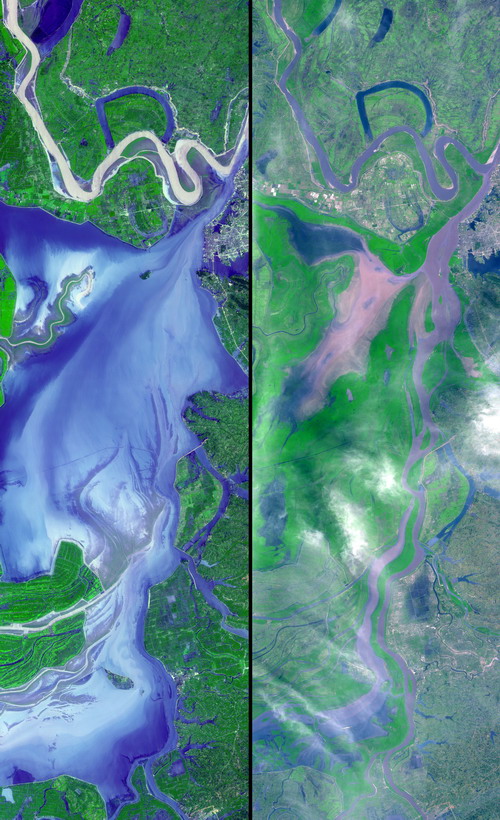How Wetland Plants Survive in Flooding and Sedmentation?
Have you ever seen the following famous images acquired by the Advanced Spaceborne Thermal Emission and Reflection Radiometer (ASTER) on the National Aeronautics and Space Administration’s (NASA's) Terra satellite in 2002 (Fig.1)? The images show dramatic change in the water at Dongting Lake in Hunan province. The left image showed the extent of the lake, while the right image was obtained before the flooding began.
As the second largest freshwater lake and the most typical river-connected lake in China, Dongting Lake is usually flooded from May to October. It is reported yesterday that the recent torrential rains has raised the water level of Dongting Lake almost to the warning line. As everyone knows that a large amount of sediment will be deposited once the flooding comes. Actually, flooding and sedimentation are major stresses limiting plant growth and distribution in wetland ecosystems.
How are the interactive effects of the two stresses? This question is puzzling researchers in Institute of Subtropical Agriculture, Chinese Academy of Sciences (ISA). Doctor PAN Ying chose young ramets of two emergent macrophytes common to the Dongting Lake wetlands: the flooding-tolerant species Carex brevicuspis C.B Clarke and the flooding-intolerant species Miscanthus sacchariflorus (Maxim.) Hackel to grow in two water levels and on three burial depths. At the same time, the morphology and physiology were investigated.
The researcher finds that the negative effects of the two stresses on plant growth were directly related to the reducing oxygen availability in root zones. The two species had similar responses to flooding or sedimentation, such as a higher leaf mass ratio and a lower starch content. These strategies are favourable for plants to emerge from the water or sediment surface to acquire oxygen. Additionally, the presence of flooding led to more serious oxygen deficit in the soil when sediment deposition occurs. These results suggest that the interactive effects of flooding and sedimentation stress would be more harmful to plants than both separate effects that need urgent attention.
Supported by Knowledge Innovation Program of the Chinese Academy of Science (KZCX2-YW-435), the National Basic Research Program of China (2012CB417005) and the National Natural Science Foundation of China (31070325), the results of the research have been published on Aquatic Botany in July,2012.(DOI: 10.1016/j.aquabot.2012.03.008)
 |
| The Dramatic Change in the Water at Dongting Lake Image credit: NASA/GSFC/METI/ERSDAC/JAROS, and U.S./Japan ASTER Science Team |
Download attachments: